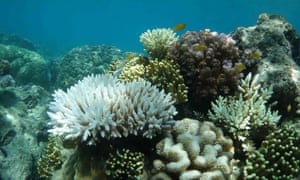This year’s bleaching likely to be widespread although less intensive than previous outbreaks, National Oceanic and Atmospheric Administration says
The Great Barrier Reef could be about to experience its most widespread outbreak of mass coral bleaching ever seen, according to an analysis from the US government’s National Oceanic and Atmospheric Administration.
But the analysis, seen by Guardian Australia, says while bleaching could hit the entire length of the world heritage-listed reef, the impacts may not be as intense as previous major outbreaks.
Pockets of bleaching are being seen in areas including Lizard Island, north of Cooktown, and more than 1,100 kilometres south-east at Heron Island, off Gladstone.
On Thursday, the Great Barrier Reef Marine Park Authority, conservationists and scientists warned that heat stress was building along most of the 2,300-kilometre reef along Queensland’s north coast.
Temperatures would need to drop from current levels over the next two weeks if the reef was to avoid a third mass bleaching event in five years.
Dr William Skirving, of Noaa’s Coral Reef Watch, prepared a briefing on the “status of heat stress on the GBR” on 19 February.
The agency’s observations and model forecasts suggested that “2020 is likely to be the most extensive coral bleaching event that we have seen so far” on the reef.
He told Guardian Australia: “We are pretty confident that it’s likely there will be bleaching right up and down the reef and you will find very few reefs that don’t have some bleaching.”But the analysis, seen by Guardian Australia, says while bleaching could hit the entire length of the world heritage-listed reef, the impacts may not be as intense as previous major outbreaks.
Pockets of bleaching are being seen in areas including Lizard Island, north of Cooktown, and more than 1,100 kilometres south-east at Heron Island, off Gladstone.
On Thursday, the Great Barrier Reef Marine Park Authority, conservationists and scientists warned that heat stress was building along most of the 2,300-kilometre reef along Queensland’s north coast.
Temperatures would need to drop from current levels over the next two weeks if the reef was to avoid a third mass bleaching event in five years.
The agency’s observations and model forecasts suggested that “2020 is likely to be the most extensive coral bleaching event that we have seen so far” on the reef.
While bleaching would be extensive, the intensity of the heat may not reach previous major bleaching events, Skirving said.
In 2016 and 2017, back-to-back bleaching killed about half the reef’s corals.
He said: “I’m expecting a bit of mortality but I don’t think this will get to the levels where we have seen large-scale mortality.”
Corals bleach if they sit in unusually warm waters for long periods. The algae that provides food and the coral’s colour separate from the animal, leaving behind a visible white skeleton.
Severe bleaching can kill some corals, and weaken others. Extreme heat can also kill corals almost immediately.
Skirving’s analysis identified a key period from 26 February to 4 March when widespread bleaching was likely to hit.
During this time, tides would be weak, meaning there was less mixing of the waters that help dissipate heat through the water column. At the same time, the unusually high ocean temperatures would remain.
He said: “We will see temperatures rocket through through that period. But if it does get really bad is yet to be seen – it depends on rain and wind – and neither of those can be precisely predicted.”
According to the panel, it had high confidence that tropical coral reefs “are projected to reach a very high risk of impact at 1.2°C [of global warming], with most available evidence suggesting that coral-dominated ecosystems will be non-existent at this temperature or higher.”
Prof Ove Hoegh-Guldberg, a marine biologist at the University of Queensland, whose early work helped to explain the link between coral bleaching and climate change, said in the past two weeks, “the risk factors for major bleaching events, like elevated water temperatures” had “increased dramatically”.
Skirving said it appeared large-scale bleaching events were happening more frequently on the reef, and listed 1983, 1987, 1998, 2002, 2016, 2017 and “now likely 2020”.
While reefs could “bounce back” from bleaching events, there was concern individual reefs would not have enough time to recover between each outbreak.
Dr Lyle Vail, director of the Australian Museum’s Lizard Island Research Station, said on Friday there was already bleaching on some corals there.
“Alarm bells are ringing, we’re in troubled waters,” he said.
Lizard Island was badly hit by bleaching in 2016. Vail added: “The coral recovery was coming along nicely so it’s hard to see it bleaching again, fingers crossed for some cloud cover and rain to cool things down.”
Several scientists working at Heron Island and the nearby One Tree Island have also been sharing images of corals beginning to bleach.
Dr Tracy Ainsworth, a coral biologist at UNSW, has been with a team of scientists at a research station on Heron Island since 15 January.
“We have been recording bleaching in the lagoon and reef flat and some exposed areas of the reef, and that’s concerning. A lot of the reef is fine though in the wave-exposed areas.”
.png)

No comments:
Post a Comment